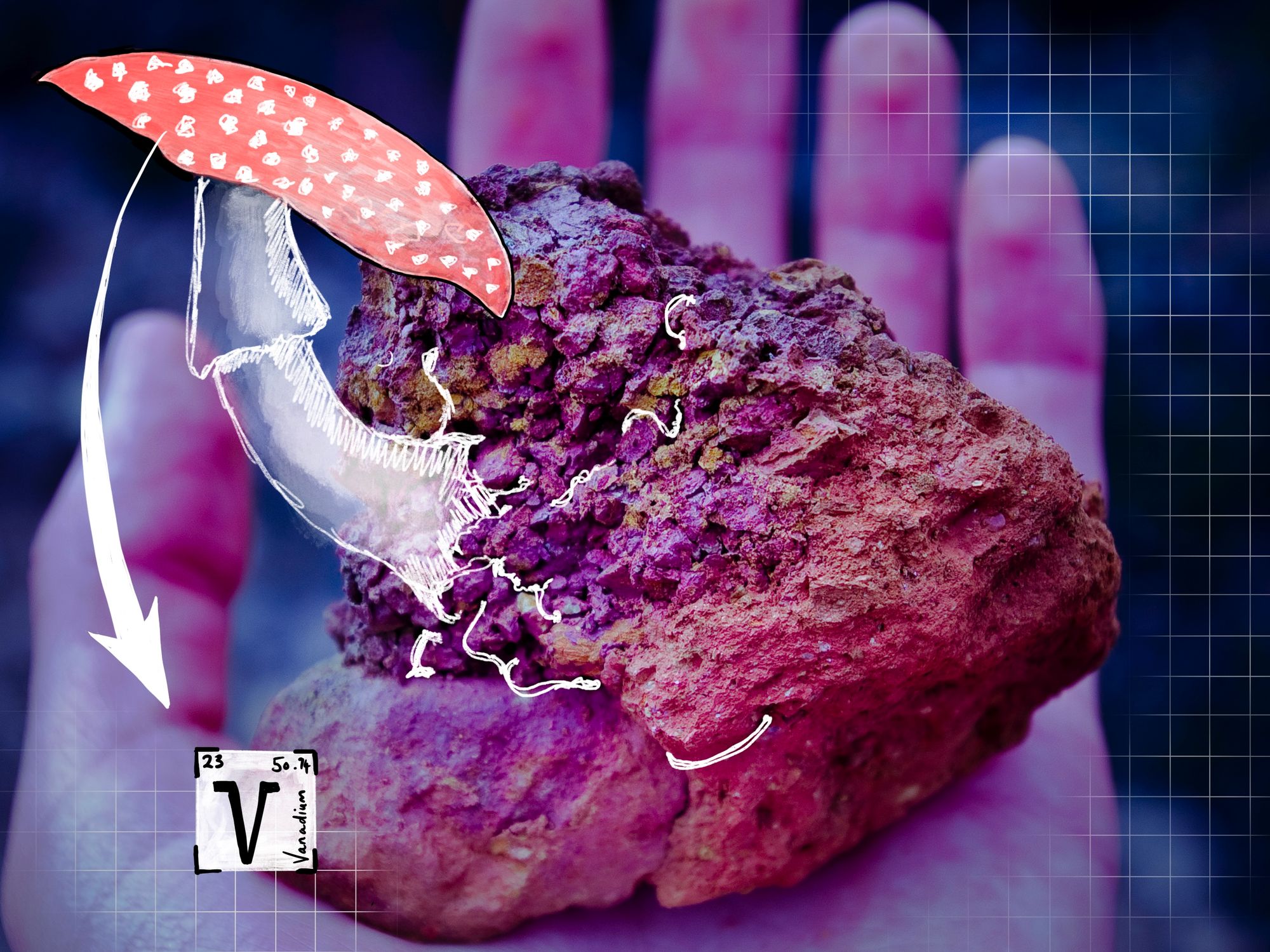How Fungi Could Decarbonize the Critical Metals Landscape

A recent trip to South Africa coincided with the time that a large oil & gas company received an injunction preventing them from conducting seismic exploration activities within the eastern cape waters1. I have always been mesmerized by whales and their complex communication channels and I could appreciate how such strong seismic signals could negatively influence their communication and associated breeding dynamics2. This was receiving much coverage at the time and it really made me appreciate the “creative tension” between our consumption of “shiny goblets” (i.e. smart devices etc.) within our modern societies and the increasing demand for scarce metals and minerals. Here I tell the brief tale of Vanadium, which acts like our chaperone that takes us into this critical metals landscape. I use Vanadium due to familiarity reasons and its broad remit in decarbonizing many aspects of our green society. The logic of this post could naturally be applied to any of the critical metals, but in the interest of time, the journey begins with Vanadium. Please join me in this curious exploration of a potential solution to metals circularity and sustainable mining.
“Hens Teeth” - A Pay-to-Play Condition in Green Technology
“As rare as hens teeth” - An English Idiom
In fact, just to appease the curiously minded, there are only a handful of known cases in which a hen has been born with teeth. But I hope to show that this is a timely idiom to keep in mind when we consider our transition to sustainable technologies. Unless eco-centric and systems thinking is applied, we are risking creating a scenario where “hens teeth” will become a pay-to-play condition within the green technology space. It’s clear that our continued trajectory in transitioning to green technologies will place an unprecedented demand on the limited supply of scarce metals and rare earth elements. Despite their name, these elements are not rare by occurrence (like hens teeth) and occur abundantly in the Earth’s crust, but it is rather a matter of concentration; they are not at high enough concentrations to be considered economically recoverable. It is also well known that within a mid-term scenario (2050-2100), several mineral resources will be needed by multiple times their current requirements3. In some respects, this reflects a sustainability’s rendition of the prisoner’s dilemma and tragedy of the commons4:
- Either we consume what we have left and suddenly mining meets a demise like typewriting and scrapyards become the new plutocracy, or,
- We collectively (assuming all participate) find a way to develop purely eco-centric technologies (using terrestrially abundant elements wherever possible) and establish product circularity alongside truly sustainable mining practices.
The first option, assuming no intervention and unbridled consumption, will likely require us to go forth and catch passing comets like a bear on a salmon run. To illustrate a scenario without intervention (such as efficient reuse and recycling); if the present rare-earth element needs within automotive and wind applications are representative of future needs over the next 25 years; following a path consistent with stabilization of atmospheric CO2 at 450 ppm, we can estimate an increase of more than 700% and 2600% for Neodynium (Nd) and Dysprosium (Dy), respectively5. The second option is both challenging and costly, but as sustainable stewards of our earth, we have an altruistic responsibility to overcome this hurdle. This will be the tenet of thought explored in this post, specifically for critical metals. There are of course other options, such as those who take a fancy at chasing comets or the once-in-a-century genius who converts a rice cooker into a “mini supernovae making machine”, which spits out minted bullions in your chosen periodic element; but these are beyond the scope of this post.
 A recent analysis
depicting the end-of-life recycling input rates of a range of critical
metals and rare earth elements. Source6.
A recent analysis
depicting the end-of-life recycling input rates of a range of critical
metals and rare earth elements. Source6.
Vanadium - Our Steely Chaperone into Critical Metals
Recent studies have have estimated that Vanadium could prevent at least 183 million tons in carbon dioxide emissions through its conventional application landscape7˒8. However, this is a notoriously difficult number to quantify since technologies are inherently systemic; therefore drawing the radial boundaries around the potential of a single element is particularly challenging. Another compounding source of error is the constant flow of research and development, which unlocks new material technology streams. In this section I aim to briefly highlight some of the current developments for Vanadium, and why, despite the relatively low abundance (22nd in the earth’s crust), the decarbonizing gearing potential of these critical metals (such as Vanadium) is truly significant. Within this context, we can then explore some creative solutions that works with nature, rather than against it. Without further ado, let us dive into the application landscape of Vanadium.
The iron and steelmaking sector accounts for over 80% of the consumed Vanadium per year, which is why we need to briefly account for steel developments before continuing. Iron is considered the most abundant metal in our Earth’s crust and by function of its circularity and sheer prevalence within our global society; any means to use less of it, reduce its embodied carbon or enhance its use phase are rightfully justified from a sustainability standpoint9. Given the advent of higher-strength steel in response to market-driven needs for lightweight designs; higher working stresses within thinner-gauge designs have placed an even greater emphasis on the performance of steel structures. A strong focus on failure-resisting steels and fatigue-reliable design is required for the sophistication of modern engineering components and structures10.
 A few years ago I was
actively engaged with upgrading and decarbonizing steel designs within
several market segments. This work was a mix of applied material
science, lifecycle analysis and structural engineering - it was
thoroughly engaging. This image depicts a sketch (one of many) that I
had prepared during a flight in preparation for a training session
themed on “lightweighting” trailers.
A few years ago I was
actively engaged with upgrading and decarbonizing steel designs within
several market segments. This work was a mix of applied material
science, lifecycle analysis and structural engineering - it was
thoroughly engaging. This image depicts a sketch (one of many) that I
had prepared during a flight in preparation for a training session
themed on “lightweighting” trailers.
But history has shown us the remarkable similarity between baking a cake and making steel; it’s the small addition of extras that are responsible for the greatest variance in both taste and performance11. Any attempt at making a cake with young children, which are positioned within leading roles, will quickly prove this hypothesis. In the same respect, alloying steel with Vanadium has a remarkable influence on the properties within a broad range of steels.
 A schematic depicting the
conventional applications for Vanadium. Source7
A schematic depicting the
conventional applications for Vanadium. Source7
Vanadium and steel have a fascinating history — the fabled Damascus Steel swords of ancient history can be thankful in-part to this remarkable element, despite trace concentrations as little as 0.004%12. At the time, the ancient blacksmiths relied on their experiences and intuition (they even used rice husks as a carbon source), but given modern research, we can now begin to appreciate the true versatility of this remarkable micro-alloy. With the advancement of modern research, we can learn how best to design steels from the nano-scale up. Such recent vanadium-alloyed nano-designed steels are not only conducive to sustainability metrics but also offer significant property enhancements:
- Remarkable combinations of strength and ductility with less alloying within high-strength low alloy steels used for lighter transportation solutions13˒14˒15˒16˒17
- Rapid transform nano-bainitic steels which offer remarkable wear-resistance properties that could significantly enhance the service lifetime of yellow-goods machinery and machinery components (such as bearings within wind turbines)18˒19˒20˒21˒22˒23˒24˒25˒26˒27
- Resource-efficient and higher-strength grain-oriented electrical steels, which could improve transformer efficiencies within the energy sector28˒29
- Lean-alloyed fire-resistant steels for safer and lighter steel-timber sustainable constructions30˒31˒32
Making Eco-Centric Technology Decisions
Looking beyond the realms of steel, vanadium dioxide is also showing great promise in enabling pivotal sustainable technologies, such as novel transistors and smart windows33. Vanadium dioxide is unique since it exhibits a metal to insulator transition (MIT), whereby doping with elements such as tungsten can control this “switching” temperature to the region of room temperatures. When the temperature is higher than a certain value (say 20°C), the infrared ray is isolated and the indoor temperature remains cool and stable34. This technology alone has significant decarbonization potential. For example, the annual carbon footprint of air conditioning is estimated to be circa 1,950 million tons of carbon dioxide35. If nano-coated smart windows could reduce the footprint of air conditioning by 50%, this saving alone is still greater than the annual emissions created by the entire EU energy supply sector in 202036. But the decarbonization opportunities continue.
Energy storage will be needed to address the intermittent nature of wind and solar electricity generation as well as battery electric vehicle (BEV). A mixture of graphite, lithium, cobalt, nickel, and manganese is needed for state-of-the-art BEV batteries (90% of the anticipated demand for energy storage), whereas vanadium is a metal of choice for static power storage for industrial needs37, such as solar and wind farms. The use of vanadium within cost-efficient redox flow battery concepts38˒39 and carbon capture technologies (circa. 100 kg of V/megawatt)40 is expected to significantly bolster demand. Based on current projections, 138 thousand tons will be consumed annually by energy storage alone by 205041. Compounding these technology opportunities with the expected 30% increase in steel consumption by 205042; this places a very high supply demand on a material that will require new production volumes, both as the prime extraction product, companion product43 and also extracted from recycled waste. But there is very much a time constraint upon us. Studies already suggest that some metals already present a mid-term depletion horizon, which suggests that for some elements, we need a radical solution to vastly accelerate recycling and recovery within waste streams. A recent ecological resource availability methodology demonstrated how current production rates will deplete the sustainably available budgets on a range of metals if we continue to produce them with current technology, today’s economic structure and current production shares in the metals sector44.
 A recent study
depicting the forecasted depletion horizons based on reserves with
demand from the energy sector (in red) ranging across energy scenarios
and demand without the energy sector (in black)45.
A recent study
depicting the forecasted depletion horizons based on reserves with
demand from the energy sector (in red) ranging across energy scenarios
and demand without the energy sector (in black)45.
However, we must be cautious with the inferences we derive when talking about resource depletion. It has also been argued that decreasing metal ore grades should not be considered as indicators of resource depletion, but rather, as the increasing environmental impacts, and resource requirements related to the exploitation of lower concentrated deposits (which can imply competition for water and land, and lead to social tensions and/or impacts) should serve as the key points of concern46.
 I recently gave a
talk on sustainable materials, whereby I highlighted the need to develop
a systems thinking approach to emergent technologies, which captures the
full lifecycle of the technology but also considers the full spectrum of
environmental, social, and governance (ESG) requirements.
I recently gave a
talk on sustainable materials, whereby I highlighted the need to develop
a systems thinking approach to emergent technologies, which captures the
full lifecycle of the technology but also considers the full spectrum of
environmental, social, and governance (ESG) requirements.
Reflecting on the above, it is clear that all emergent technologies within the green technology space must undergo an eco-centric due-diligence, whereby technologies are weighed from a cradle-to-grave lifecycle perspective47˒48˒49. As social (such as poor labor conditions50), economic, and environmental sustainability concerns also grow, the trend of considering broader implications of material selection beyond cost and functionality is thankfully becoming more common51.
The art of systems thinking is one of those approaches that reserves its greatest benefit to its diligent practitioners. Systems thinking allows for a more comprehensive understanding of how a technology will impact a system as a whole. This can be especially helpful when making decisions about emergent technologies, which may have unpredictable consequences. Systems thinking can help to identify potential risks and benefits of a technology, and to plan for how it can be best integrated into a system.
 I am ever so thankful
for the excellent training that I received many years ago from Burgh
Hughes Walsh52. I would fully recommend them
if a reader wishes to implement more systems thinking within their
current organization. Image source52.
I am ever so thankful
for the excellent training that I received many years ago from Burgh
Hughes Walsh52. I would fully recommend them
if a reader wishes to implement more systems thinking within their
current organization. Image source52.
From a technology mix perspective, there has been some progress in optimizing the mix of green technologies (wind energy, solar etc.) that serve to meet future energy demands but also minimize the environmental impact45. But this still does not address the sourcing of the elements that constitute these technologies. So putting on our systems thinking hats, how do we find an eco-centric solution that satisfies the plethora of requirements (whereby some of which are conflicting) for a sustainable mining and waste recovery solution?
They often say a walk in the woods is good for the soul, but in this case, there could be more benefit that one initially realizes.
The Humble Fungus - A Metals Accumulator
The hunt for new and undiscovered ore bodies is partly activated by a steady decrease in the global average grade of ores, which cannot be compensated by improving and upgrading mining technologies53. Improvements in mining technologies compensate for declining ore grades, but the energy cost of extraction keeps growing, with potential impacts on renewables54. One of the more sensitive search domains for new mineral ore bodies are sub-sea deposits. Recent studies have demonstrated that such deposits are of high-grade55 but are fraught with environmental risks not only during mineral extraction but also during exploration using seismic technologies56˒57.
Fungi play a dominant role in terrestrial environments (both land and ocean58) where they thrive in symbiotic associations with plants and animals and are integral to nutrient cycling within diverse ecosystems. But hidden within the labyrinth of intricate corridors of mycelium and majestic sporophores resides an incredible ability to extract metals from ores, which is called fungal bioleaching. But admittedly, this field of research is relatively underexplored. Recent studies have shown how fungi such as Aspergillus Niger was able to leach Copper and Cerium from phosphate minerals59, but also elements such as Cobalt and Zinc60. A recent review of this landscape contrasted this method against other conventional and physical extraction of rare earth and scarce metals61. It was concluded that given some minor process optimization, fungal bioleaching may be more profitable because of several economic and environmental advantages such as low carbon emissions, low waste generation and low energy demand (the reactions are carried out under ambient conditions)61.
But what about Vanadium, can the humble fungus offer a sustainable solution to low-grade ore extraction and waste recovery solutions?
The unusual accumulation of vanadium in a specific toadstool (the well-known “fly agaric”, from the Amanita genus) was discovered in 1931, apparently by chance, by Ter Meulen62. Within these mushrooms, Vanadium is bound with a binding molecule called ‘amavadin’ and has been found in concentrations as high as 1g of V per kg of A.muscaria63˒64. Furthermore it was established that the accumulation of vanadium was not dependent on the age of the mushrooms neither related to the contents of the soil.
Given further research and process optimization, it is clear that fungal bioleaching could serve as a nature-friendly solution at both the cradle and the grave of a given product’s lifecycle. As we explored in this post, many metals are not in isolation within ore bodies and the extent of biological complexity here would be very high43. However, like the sustainable stewards we are, this challenge should be seen as an opportunity, and with the right tools, we can develop the right solution. To illustrate; recent research has also shown the novelty of amavadin and how it could act as an enabler towards lower-cost and more-efficient vanadium-redox flow batteries65. I believe we have only scratched the surface in this respect and fungal bioleaching holds great potential in optimizing extraction but also in finding novel bioinspired molecules that bolster the technologies they serve.
At the time of this writing, the football world cup is currently underway in Qatar. It has been a thrilling and enjoyable display of football, but equally, we could ask ourselves; given the hurdles that lay ahead of our global society, how efficient is our usage of capital in this world. If 1% of the recent $220 billion investment capital that has gone into the 2022 World Cup66, was instead set aside to develop efficient fungal bioleaching solutions; it could have sent a tidal wave of decarbonization savings throughout the fundamental technologies that serve as a bedrock to our greener future. Given proper investment and policy support; a future mine could potentially resemble a fungal garden rather than a scar within the Earth’s crust. I believe this certainly merits reflection and reinforces the pivotal role of leadership and wise decision making within the sustainability landscape.
Thanks for taking the time to read this and Godspeed.
/Aaron
Author's update: if curious about a truly eco-friendly solution that can contribute to this narrative of metal circularity and regenerative mining practices, please also look at FungAI, https://fungai.bio/.

